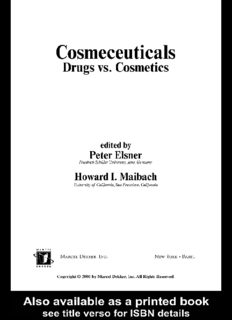
Cosmeceuticals: Drugs vs. Cosmetics (Cosmetic Science and Technology) PDF
Preview Cosmeceuticals: Drugs vs. Cosmetics (Cosmetic Science and Technology)
Cosmeceuticals Drugs vs. Cosmetics edited by Peter Elsner Friedrich Schiller University,Jena,Germany Howard I. Maibach University of California,San Francisco,California Marcel Dekker, Inc. New York Basel • TM Copyright ©2000 by Marcel Dekker,Inc. All Rights Reserved. This edition published in the Taylor & Francis e-Library, 2004. “To purchase your own copy of this or any of Taylor & Francis or Routledge’s collection of thousands of eBooks please go to www.eBookstore.tandf.co.uk.” ISBN:0-8247-0305-7(Print Edition) ISBN 0-203-90468-0 Master e-book ISBN Headquarters Marcel Dekker, Inc. 270Madison Avenue, NewYork, NY10016 tel: 212-696-9000; fax: 212-685-4540 EasternHemisphere Distribution Marcel Dekker AG Hutgasse 4,Postfach 812,CH-4001 Basel, Switzerland tel: 41-61-261-8482; fax: 41-61-261-8896 WorldWideWeb http://www.dekker.com The publisher offers discounts on this book when ordered in bulk quantities. For more information, write to S pecial Sales/Professional Marketing at the headquarters address above. Copyright 2000byMarcelDekker,Inc. AllRightsReserved. Neither this book nor any part may be reproduced or transmitted in any form or by any means, electronic or mechanical, including photocopying, microfilming, and recording, or by any information storage and retrieval system, without permission in writing from the publisher. AbouttheSeries TheCosmeticScienceandTechnologyserieswasconceivedtopermitdiscussionofabroad rangeofcurrentknowledgeandtheoriesofcosmeticscienceandtechnology.Theseriesis composedofbothbookswrittenbyasingleauthorandeditedvolumeswithanumberof contributors.Authoritiesfromindustry,academia,andthegovernmentparticipateinwriting thesebooks. Theaimoftheseriesistocoverthemanyfacetsofcosmeticscienceandtechnology.Topicsare drawnfromawidespectrumofdisciplinesrangingfromchemistry,physics,biochemistry,and analyticalandconsumerevaluationstosafety,efficacy,toxicity,andregulatoryquestions. Organic,inorganic,physicalandpolymerchemistry,emulsionandlipidtechnology, microbiology,dermatology,andtoxicologyallplayimportantrolesincosmeticscience. Thereislittlecommonalityinthescientificmethods,processes,andformulationsrequiredfor thewidevarietyofcosmeticsandtoiletriesinthemarket.Productsrangefrompreparationsfor hair,oral,andskincaretolipsticks,nailpolishesandextenders,deodorants,bodypowdersand aerosols,toquasi-pharmaceuticalover-the-counterproductssuchasantiperspirants,dandruff shampoos,antimicrobialsoaps,andacneandsunscreenproducts. Cosmeticsandtoiletriesrepresentahighlydiversifiedfieldinvolvingmanysubsectionsof scienceand“art.”Eveninthesedaysofhightechnology,artandintuitioncontinuetoplayan importantpartinthedevelopmentofformulations,theirevaluation,selectionofrawmaterials, and,perhapsmostimportantly,thesuccessfulmarketingofnewproducts.Theapplicationof moresophisticatedscientificmethodologiesthatgainedsteaminthe1980shasincreasedinsuch areasasclaimsubstantiation,safetytesting,producttesting,andchemicalanalysisandhasledto abetterunderstandingofthepropertiesofskinandhair.Molecularmodelingtechniquesare beginningtobeappliedtodataobtainedinskinsensorystudies. EmphasisintheCosmeticScienceandTechnologyseriesisplacedonreportingthecurrent statusofcosmetictechnologyandscienceandchangingregulatoryclimatesandpresenting historicalreviews.Theserieshasnowgrownto26booksdealingwiththeconstantlychanging technologiesandtrendsinthecosmeticindustry,includingglobalization.Severalofthevolumes havebeentranslatedintoJapaneseandChinese.Contributionsrangefromhighlysophisticated andscientifictreatisestoprimersandpresentationsofpracticalapplications.Authorsare encouragedtopresenttheirownconceptsaswellasestablishedtheories.Contributorshavebeen askednottoshyawayfromfieldsthatareinastateoftransition,nortohesitatetopresent detaileddiscussionsoftheirownwork.Altogether,weintendtodevelopinthisseriesa collectionofcriticalsurveysandideascoveringdiversephasesofthecosmeticindustry. The13chaptersinMultifunctionalCosmeticscovermultifunctionalproductsforhair,nail,oral, andskincare,aswellasproductswithenhancedsunscreenandantimicrobialpropertiesSeveral chaptersdealwiththedevelopmentofclaimsupportdata,theroleofpackaging,andconsumer researchontheperceptionofmultifunctionalcosmeticproducts.Theauthorskeepinmindthat inthecaseofcosmetics,itisnotonlythephysicaleffectsthatcanbemeasuredontheskinor hair,butalsothesensoryeffectsthathavetobetakenintoaccount.Cosmeticscanhavea psychologicalandsocialimpactthatcannotbeunderestimated. Iwanttothankallthecontributorsforparticipatinginthisprojectandparticularlytheeditors, PerryRomanowskiandRandySchueller,forconceiving,organizing,andcoordinatingthisbook. Itisthesecondbookthattheyhavecontributedtothisseriesandweappreciatetheirefforts. SpecialthanksareduetoSandraBebermanandErinNihilloftheeditorialandproductionstaff atMarcelDekker,Inc.Finally,Iwouldliketothankmywife,Eva,withoutwhoseconstant supportandeditorialhelpIwouldnothaveundertakenthisproject. EricJungermann,Ph.D. COSMETICSCIENCEANDTECHNOLOGY SeriesEditor ERICJUNGERMANN JungermannAssociates,Inc. Phoenix,Arizona 1. Cosmetic and Drug Preservation: Principles and Practice, editedby JonJ.Kabara 2. The Cosmetic Industry: Scientific and Regulatory Foundations, edited byNormanF.Estrin 3. Cosmetic Product Testing: A Modern Psychophysical Approach, HowardR.Moskowitz 4. Cosmetic Analysis: Selective Methods and Techniques, editedbyP. Bor(cid:31) 5. CosmeticSafety:APrimerforCosmeticScientists,editedbyJamesH. Whittam 6. OralHygieneProductsandPractice,MortonPader 7. Antiperspirants and Deodorants, edited by Karl Laden and Carl B. Felger 8. Clinical Safety and Efficacy Testing of Cosmetics,editedbyWilliamC. Waggoner 9. Methods for Cutaneous Investigation, editedbyRobertL.Rietschel andThomasS.Spencer 10. Sunscreens:Development,Evaluation,andRegulatoryAspects,edited byNicholasJ.LoweandNadimA.Shaath 11. Glycerine: A Key Cosmetic Ingredient,editedbyEricJungermannand NormanO.V.Sonntag 12. HandbookofCosmeticMicrobiology,DonaldS.Orth 13. Rheological Properties of Cosmetics and Toiletries, editedbyDennis Laba 14. Consumer Testing and Evaluation of Personal Care Products,Howard R.Moskowitz 15. Sunscreens: Development, Evaluation, and Regulatory Aspects. Sec- ond Edition, Revised and Expanded, editedbyNicholasJ.Lowe,Na- dimA.Shaath,andMadhuA.Pathak 16. Preservative-Free and Self-Preserving Cosmetics and Drugs: PrinciplesandPractice,editedbyJonJ.KabaraandDonaldS.Orth 17. HairandHairCare,editedbyDaleH.Johnson 18. CosmeticClaimsSubstantiation,editedbyLouiseB.Aust 19. Novel Cosmetic Delivery Systems, editedbyShlomoMagdassiand ElkaTouitou 20. Antiperspirants and Deodorants: Second Edition, Revised and Ex- panded,editedbyKarlLaden 21. Conditioning Agents for Hair and Skin,editedbyRandySchuellerand PerryRomanowski 22. Principles of Polymer Science and Technology in Cosmetics and Per- sonalCare,editedbyE.DesmondGoddardandJamesV.Gruber 23. Cosmeceuticals: Drugs vs. Cosmetics, edited by Peter Elsner and HowardI.Maibach 24. CosmeticLipidsandtheSkinBarrier,editedbyThomasF(cid:31)rster 25. Skin Moisturization, editedbyJamesJ.LeydenandAnthonyV.Raw- lings 26. MultifunctionalCosmetics,editedbyRandySchuellerandPerryRoma- nowski ADDITIONALVOLUMESINPREPARATION Preface Theterm‘‘cosmeceuticals,’’coinedbyAlbertKligman20 yearsago,hasright- fullyprovokedthoughtanddiscussionamongscientists,industry,andregulating authorities. Basically, the controversy revolves around the question of whether there areany substances applied tothe skin thatdo not modify itsstructure and function. Since scientific evidence shows that even purportedly ‘‘inert’’ sub- stances such as water may profoundly change the structure and function of the skin,thisdoes notseemhelpfulindistinguishingcosmeticsfromdrugs.Indeed, thereisalegalproblemwiththedefinitionofcosmeticsintheUnitedStates,but not in other major countries such as Europe and Japan. InEurope,theCouncilDirective76/768/EECof27July1976,asamended by six Directives, defines cosmetic products in Article 1: Acosmeticproductmeansanysubstanceorpreparationintendedforplacing intocontactwiththevariouspartsofthehumanbody(epidermis,hairsystem, nails,lipsand externalgenitalorgans)orwiththe teethandmucousmem- branesoftheoralcavitywithaviewexclusivelyorprincipallytocleaning them, perfuming them or protecting them, in order to keep them in good condition,changetheirappearanceorcorrectbodyodours. Thus,acosmeticisdefinedbyitsmode ofapplicationandbytheintention with whichitisused.Whilecosmeticsareusedonnormalornearlynormalskin,drugs are defined as preparations to be used for the treatment of diseased skin. Obvi- ously, there remains a gray zone between what is considered ‘‘normal’’ as op- posedto‘‘diseased’’skin.Thismayvarydependingontheindividual,thesociety, and over time. In this situation, Article 2 of the Council Directive is helpful. AcosmeticproductputonthemarketwithintheCommunitymustnotcause damagetohumanhealthwhenappliedundernormalorreasonablyforesee- ableconditions ofuse. Therefore,consumersafetyisofutmostimportanceincosmetics,whileitisarela- tiveissueindrugs,whereabalancedbenefit–riskassessmenthastobemadede- v vi Preface pending on the severity of the disease. This is reflected by a recent decision of theScientificCommitteeonCosmeticsandNon-FoodProducts(SCCNFP)ofthe European Commission regarding the use of the antifungal ketoconazole in cos- metics. Following a thorough review of the safety profile of the substance, the SCCNFPdecidedthattherewerenosafetyconcernsinusingupto2%ketocona- zoleincosmeticproducts.Obviously,thisonlyreferstothecosmeticuseofketa- conazole-containingproducts(e.g.,asantidandruffpreparations);whenusedtotreat fungalskindisease,theywouldbeconsidereddrugsfromaregulatorypointofview. TheCouncilofEuropeisanintergovernmentalinstitutionthatfosterscoop- erationbetween Europeancountries.Membersarenot onlytheEuropeanUnion memberstates,butalsonearlyallothercountriesontheEuropeanContinent.Its PublicHealth Committee/Committee of Expertson CosmeticProducts statesin a recent document (Comparative Study on Borderline Products and Borderline Situations,RD4-1/32/1999)thatacosmeticproducthastofulfillthefourcriteria offunction(Art.1asabove);presentation(i.e.,theclaimsmadefortheproduct); mode of application (i.e., externally or on the mucous membranes of the oral cavity);andcomposition(i.e.,notcontainingaprohibitedsubstanceortoomuch ofaregulatedsubstance).TheCommitteehasanalyzedthesecriteriaforanumber of cosmetic designations and substances and found that remarkable differences existintheregulatoryapproachbetweencountries.Forexample,inSwitzerland, productscontainingupto10%αhydroxyacidsareconsideredcosmetics,whereas concentrationsabove10%leadtotheclassificationofpharmaceutical.InAustria, theconcentrationlimitis30%,whilethereisnolimitinBelgium,Finland,Ger- many,theNetherlands,andtheU.K.(RD4-1/32/1999).Sincedifferentclassifi- cationofthesameproductshindersfreemovementofgoodsandhasanegative effectontheestablishmentandfunctioningofacommonmarket,theCommittee rightfully proposes to start a harmonization process regarding these borderline products, and states Such a harmonisation process may come to the benefit of all parties in- volved—includin gtheconsumer. We hope that this book will contribute to a sincere discussion of the status of ‘‘cosmeceuticals,’’productsthatareintendedforcosmeticusebutcontainactive substances. Since people worldwide are getting older, becoming more aware of their skin health and appearance, and more committed to use safe and effective products to achieve this goal, this debate is a timely one. Finally,wewouldliketo taketheopportunitytothankthecontributorsto thisbook,allexpertsintheirfields,whodevotedtimeandefforttotheirchapters. We are also indebtedto SandraBeberman and ElyceMisher ofMarcel Dekker, Publishers, who were more than helpful in the editorial process. Peter Elsner Howard I. Maibach
Description: